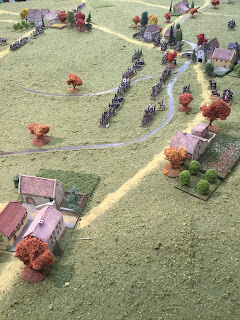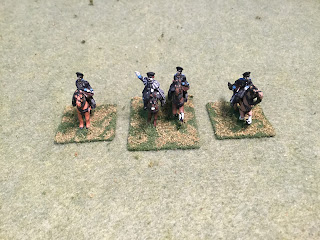Gathering in beautiful Roanoke, Virginia for the last big game of the year, this past weekend turned out to be one of our most impressive and bloodiest fights to date. Doug Kline of Battlefield Terrain Concepts provided the terrain, figures, and German beer. Doug has been researching this landmark battle for over a year, while simultaneously gathering the entire orders of battle for both sides. He fielded approximately 75,000 troops at a 33:1 scale on some of the most magnificent terrain that we have ever had the pleasure of playing on. That's approximately 2,275 of finely painted figures folks ! As always, we used the Carnage and Glory 2 computer-moderated rules. The experience was tremendous; what a way to end the year.
The gang......ready to do battle !
The Scenario
After the victory against the Austrians and Russians in 1805, the Emperor Napoleon and France were faced with a new coalition, with Prussia as the major belligerent. So setting its sights on the destruction of the Prussian army, the Grande Armee under Napoleon moved in a lightning strike against their totally unprepared enemy, who had advanced into Saxony. After a skirmish on October 9th at Schleiz, the day after saw Marshal Lannes' corps destroying a Prussian division under Prince Louis Ferdinand at Saalfield. The stage was set for the major battle against the main Prussian army that Napoleon was looking for.
On October 14th, 1806, the Emperor Napoleon led the bulk of the Grande Armee against what he assumed was the main Prussian army at Jena. It turned out to be only a contingent of the Prussians and they were duly crushed. Meanwhile, north of Jena in the vicinity of Auerstadt, Marshal Davout's lone corps tangled with the primary Prussian force under the Duke of Brunswick and von Schmettau. The Prussian King William was also present for the fight. Although outnumbered almost 2 to 1, Davout's III Corps decisively defeated the Prussians in one of the most famous of all Napoleonic battles.
In the historical battle. Napoleon intended for Marshal Bernadotte to march with Davout, but either through miscommunication or outright insubordination, Bernadotte ended up marching between the battles and failing to take part in either Jena or Auerstadt.
The battlefield of Auerstadt was located in hilly terrain west of the Saale river. The central position was dominated by the village of Hassenhausen. The road to the town of Auerstadt continued on through the villages of Tauchwitz and Poppel.
Map of the battle
In the early morning of October 14th, Gudin's division was on the move in the fog at 4 am towards Hassenhausen. French chasseurs scouting ahead came into contact with Prussian cavalry at the village of Poppel around 7 am. The French cavalry fell back to Hassenhausen and Gudin deployed into squares. As the fog lifted , Gudin saw that his division faced up to ten squadrons of Prussian cavalry under Blucher on his flank. At this point, our tabletop battle began, as Gudin faced the rest of the advancing Prussian army.
Historically, Friant's infantry division of III Corps arrived to support Gudin's right flank, advancing in square formations to push Blucher's cavalry. The rest of the corps cavalry arrived and later in the day, Morand's division arrived on Gudin's left. The French not only held their ground against superior odds, but commenced to go on the attack. As Davout launched his assault, the Prussians melted. The battle was a disaster for the Prussians, as they lost approximately 15,000 troops while Davout lost approximately 6,850. The Prussians also lost the venerable Duke of Brunswick, as well as several other key officers.
Our scenario began with Gudin's French division deployed around Hassenhausen. Blucher's Prussian cavalry was deployed facing Gudin's right flank and von Schmettau's division was deployed and advancing from the vicinity of Poppel and Tauchwitz.
Various victory points were also designated for terrain features, which would help to determine the final victory resolution. The game was slated for 20 turns (we ended at 16 turns).
The Game
The game opened with General de Division Gudin's infantry division deployed around the village of Hassenhausen in the center of the table. Opposing the right flank of the French was a large force of cavalry under Blucher, located in front of Spielberg. Most of Gudin's battalions were formed in square formation on his right, while his left were held by 2 battalions of the 85th Ligne. In the distance, Prussian infantry and cavalry were advancing from the direction of Auerstadt in force.
Blucher's cavalry threaten Gudin's right as Prussian infantry and cavalry advance in the center
Gudin's left flank seemed very vulnerable
The first several turns saw Blucher's cavalry attempting to engage the French infantry squares (with little success - although 2 squadrons of the Bunting Kurassier did destroy a small French battery of two 4 pounders), with the Queen's Dragoons attempting to flow around the right flank of the French. This forced the French to activate his own light cavalry, the 1st Chasseurs a Cheval, to counter this move. The French cavalry threw the Prussians back. Prussian artillery began to punish the tightly packed French in squares while von Schmettau's division continued its advance onto the French center. On the French left, von Wartensleben's division rapidly advanced in maneuver columns towards the 85th Ligne. The cavalry advanced so rapidly that the 2 French battalions on the left flank had to double back in open order to a more secure position (one battalion of the 85th moving into the village of Hassenhausen, the other battalion attempting to take advantage of a sunken road for cover).
Gudin's division in the center
von Schmettau's division on the move !
On Turn 3, General de Division Friant's force arrived on Gudin's right and immediately formed the 33rd Ligne to advance in squares, which pushed Blucher's cavalry away from the French right flank. In the center, French skirmishers put very disruptive fire on a Prussian battery that moved a bit too close for comfort. French light cavalry under General de Brigade Viallanes arrived with Friant's force but were diverted to the left flank to counter the rapidly advancing Prussian cavalry.
Nice shot of von Schmettau's infantry advancing
The 85th Ligne falls back in open order on the left flank
Gudin and von Schmettau are fully engaged in the center around Hassenhausen
French Chasseurs drive back Prussian Dragoons as the infantry in squares continue to take a pounding. Notice the regimental square formed by two battalions of the 25th and 21st Ligne
At this point in the battle, the Prussians engage and pound Gudin's division around Hassenhausen, while Prussian cavalry and artillery continue to build up on the French left. Cavalry then engage each other on the French left with neither side overcoming the other. With more Prussians arriving all over the field, the fatigue that is setting in on the French is starting to become a real concern.
Prussians and French infantry fight over Hassenhausen. This savage fight would continue throughout the entire game, with the French barely hanging onto the village
The fight over Hassenhausen was just starting, but would continue until the end of the battle. Although stretched to their limits and considerably bloodied, the French infantry would continue to hold out in this important victory objective. The next several turns would see more and more chaos on the French left, with Morand's division arriving on Turn 7 to bolster the fatigued French cavalry. More and more Prussian troops continued to arrive on the left flank and in front of Hassenhausen. On the French right and center, the Prince of Orange's division was advancing admirably. The beleaguered French infantry of Gudin's division were being stretched across the table; this fresh Prussian infantry was not a welcome sight (although the troops looked handsome marching in maneuver columns).
Chaos erupts on the French left !
Magnificent troops of the Prince of Orange's division march against the fatigued French
At this point, the battle turned into a slow grind, with the Prussians steadily wearing down their French opponents. With a Prussian battery wreaking havoc on Friant's infantry on the right flank, the French attempted to charge and eliminate it. Failing in the face of ferocious canister fire, the 2/33rd Ligne was then charged by Prussian cavalry and decimated. The battery had to withdraw due to fatigue, but the French had to reorganize their defense on this flank with one less battalion. In the center, the 2/1st Chasseurs charged Prussian infantry and overran it, but ended up isolating itself in front of multiple Prussian cavalry units. One after another, the French Chasseurs charged and countercharged Prussian cavalry and ended up winning 3 melees before finally succumbing to fatigue. Another lucky charge by the 1/21st Ligne overran 2 Prussian infantry battalions and an unlucky artillery battery that deployed at the last minute. But the grind continued and the Prussians were gaining ground inch by inch. As a matter of satisfaction for Marshal Davout, the 2/1st Chasseurs would end up winning honors by the end of the game.
Also, by this point, the Prussians had occupied two terrain points for Victory conditions, Hill 266 on the French left flank and Spielberg on the right. The French were holding their own on all fronts, but the possibility of an offensive move was looking more and more dim. The Prussians were winning this battle.
The 2/21st Ligne charging !
The Prussians continuing to advance on the French right -- the Lieb Karabiniers look especially striking
The Prince of Orange continues to advance on the French center and right flank
With the withdrawal of the exhausted 2/1st Chasseurs, Prussian cavalry advance against a French 12 pounder battery, with nasty results -- the battery held its ground......for now
At this point, Prussian infantry and French infantry were fully engaged in the center and both flanks. On the right, the Prussians succeeded in stepping up and blowing holes in the French ranks, with the French infantry obliging as well. Although the French were holding due to an overall morale superiority, the Prussian infantry was incredibly damaging (with fresh Prussians advancing in support). The French confidence was beginning to waver....
Prussian and French infantry trade murderous fire in the center and on the French right flank
Across the entire field, the action was total chaos. Both sides charged, countercharged, and traded vicious fire. This was some of the bloodiest fighting that we have ever simulated on the tabletop. By turn 16, we had gamed for over 18 hours over 2 days. At this point, with even more Prussian reinforcements arriving, the French were close to their breaking point. We called the game at that point, due to the impossibility of the French to mount a proper counterattack and recapture the important terrain features for victory point purposes.
More chaos in the center
....and more chaos on the French left
Panoramic view of the table at the end of battle
The game was one of the finest gaming experiences that we have ever had. Although Davout's III Corps was an incredible war machine with very high ratings, the continuous advance of a seemingly unstoppable flow of Prussians rendered it exhausted by the end of the game. Although 4 more turns remained in the formal game, it was obvious what the end result would be. When adding in the Victory points for the captured terrain features, the game ended as a Major Prussian victory, although the French admirably fought tooth and nail. Both sides played incredibly well, and it was a fitting end to an awesome weekend. Another outstanding battle using Carnage and Glory 2 was in the books !
Final casualties were 8964 men of all arms for the French, while the Prussians suffered 9537 men of all arms. This was 29% of the total French force but only 20% of the Prussians. The Prussians also controlled a majority of the available victory points for the terrain objectives.














































